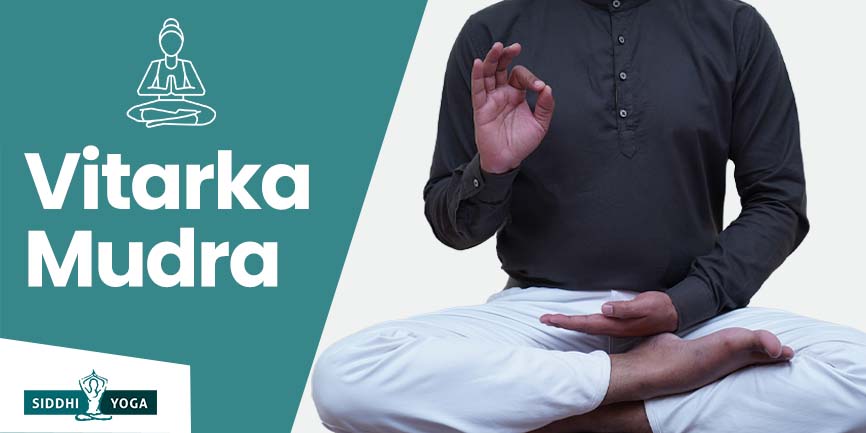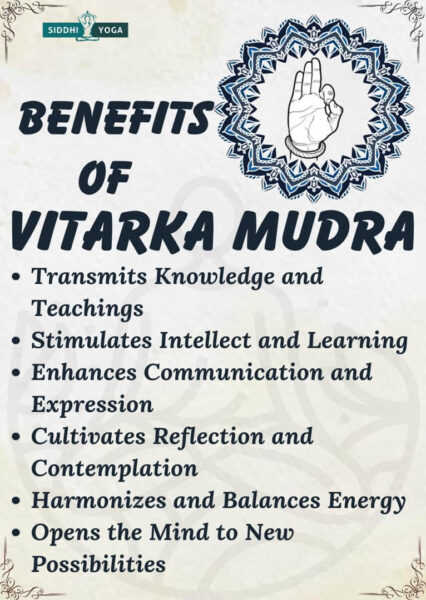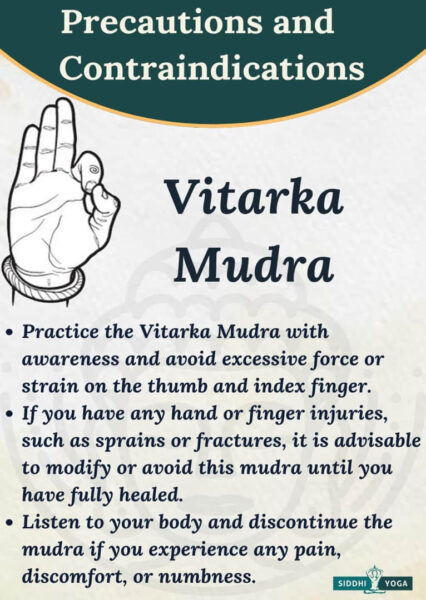
The Vitarka Mudra is an ancient hand gesture used in meditation and yoga. This article teaches you how to do it, the benefits of practicing it, and what yogic scriptures say about this pose.
What is Vitarka Mudra? Its Meaning, References, and Mythology
Vitarka Mudra is a type of Hasta Mudra or hand gesture/seal. For a better understanding of this Mudra, let us break it down into two different words.
Vitarka – Vitarka is a Sanskrit word used to describe reasoning, positive discussion, or teaching.
Mudra – the word Mudra is used to describe hand gestures or seals.
This Mudra can also be known as a “Gesture of Discussion (or Discussion gesture)” or “Gesture of Debate.”
This Mudra is quite similar to that of Gyana Mudra; some even call it a variation of Gyana Mudra or Jnana Mudra. This Mudra can also be found in some of the Christian depictions of Jesus Christ as well.
Vitarka Mudra is one of the famous Buddha depictions; this Mudra is often used to depict Buddha’s teaching. This Mudra is deeply related to the instructions. It is believed that when the Buddha gave his first teaching at Sarnath, located on the outskirts of Varanasi, India, he used this Mudra.
In Hindu Mythology, Tarka–Vitarka has a vital role, translation of Tarka and Vitarka is “A healthy discussion.” Tarka and Vitarka were a way of teaching in ancient Hindu schools called Gurukulam. Even if you look at different texts of Hindu mythologies, you will get that they were based on healthy discussion or Tarka and Vitarka. While a Guru is teaching something, a student can always come up with doubts based on curiosity, and the Guru will have to answer them. This way, old Indian schools emphasized the students’ interests.
When we practice Vitarka Mudra, we bring Gyan Mudra close to the heart; it is believed to depict “Wisdom.”
Alternate names of Vitarka Mudra
Gesture of Discussion, Gesture of Debate.
How to practice Vitarka Mudra?
- Although you can practice this while practicing any comfortable posture, it doesn’t matter if it is standing or sitting. However, we should practice it in a relaxed meditative posture to achieve good results and concentration.
- We will start by sitting in a comfortable meditative posture, for example, Lotus Pose (Padmasana) or Auspicious Pose (Swastikasana).
- The neck and spine should be comfortably erect.
- Full awareness should be focused on the breath.
- Place your hands comfortably on your knees.
- Keep your palms facing upward towards the sky.
- Now, slowly and gently join your right-hand index finger and thumb.
- This way, you create a circle in your right hand. Unlike Gyan Mudra, you can comfortably relax your left palm on your knee.
- Keep the remaining fingers of your right hand comfortably extended.
- And now, slowly bend your elbows and bring your right hand to chest level. However, one thing to note is that this Mudra was historically used to be practiced with the right hand, but you can also practice it with your left hand.
- Slowly & comfortably close your eyes if you feel comfortable doing so.
- Bring your awareness to the breath and breath as deeply as you can
- Now, if you feel comfortable, you can add om mantra chanting for deeper concentration.
Benefits of Vitarka Mudra

- The benefits of this Mudra and Gyana Mudra are pretty similar. However, this Mudra emphasizes wisdom.
- The internalization of Prana. As it redirects the pranic flow, it helps avoid leakage of pranic energy.
- This Mudra brings wisdom and helps distribute and gain knowledge.
- It calms the mind, makes you feel relaxed, and becomes aware of your inner self. You learn to communicate with your inner wisdom.
- It is also believed that it brings good fortune.
- It improves concentration.
Precautions and Contraindications of Vitarka Mudra

Similar to all other Mudra practices, it has no side effects.
However, there are a few things to consider.
- Do not firmly press your index finger and thumb against each other. They should be slightly touching each other and not put excessive pressure.
- Keep your spine comfortably erect without causing any discomfort.
When and How long to do Vitarka Mudra?
- This Mudra can be practiced if you want to attain knowledge.
- If you are seeking wisdom, then you should practice it.
- If you want to control the leakage of your pranic energy.
- This Mudra can be practiced whenever you feel you are lacking focus. Especially those days when you feel dull. You think that you lack courage and energy.
Morning is the ideal time to do any yoga or Mudra. In the morning, at this time during the daytime, our brain is at its best. So, you are more likely to be able to concentrate easily. Therefore, you should practice this Mudra from 4 am and 6 am to get the most effective outcomes.
If you are having difficulty with this during the morning, you can do this Mudra later in the evening too.
Practicing this Mudra for a minimum of 30-40 minutes daily is recommended. Whether you wish to complete it in one stretch or two threes that last between 10 and 15 minutes, it’s up to you. Based on research, the best way to practice an exercise for at least 20 minutes is to get the best benefits of that particular Mudra.
Breathing in Vitarka Mudra
You can practice breathing techniques to amplify your Mudra practice:
- You can practice Yogic breathing while practicing this Mudra.
Visualization in Vitarka Mudra
Visualize the last time when you had a healthy discussion with someone
How did you feel?
Did you feel confident?
Try remembering the things that make you more curious.
Affirmation in Vitarka Mudra
While practicing this, Keep a positive intention. Start with: I forgive myself and all others and do not seek revenge. All I want is happiness.
Conclusion
The Vitarka mudra is a gesture of debate, and its practice can help you in many ways. It is beneficial for your brain, body, and mind. We have just what you need if you are looking for an online course to learn more about the mudras or want to start practicing this one. Our Mudras Certification Course will give you all the information about 108 mudras.